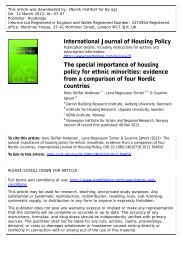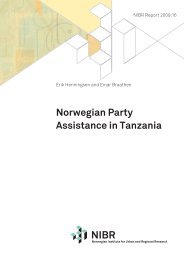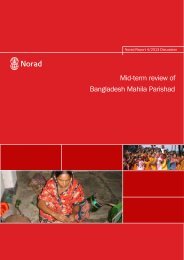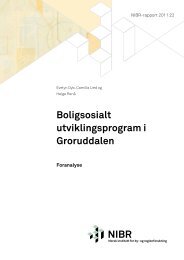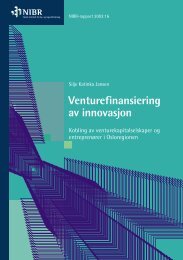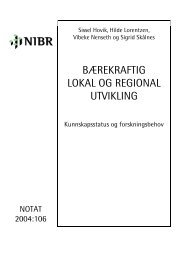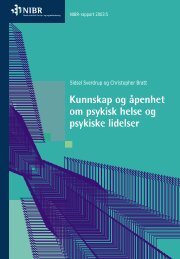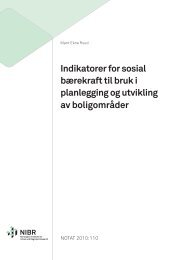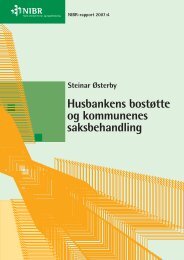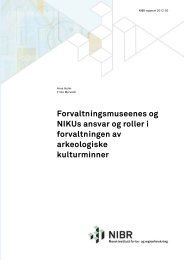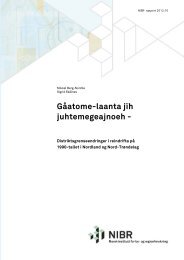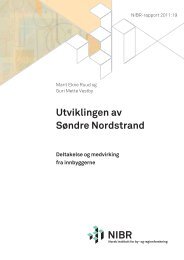Evaluation of the Southern and Eastern Africa Regional Centre for ...
Evaluation of the Southern and Eastern Africa Regional Centre for ...
Evaluation of the Southern and Eastern Africa Regional Centre for ...
- No tags were found...
You also want an ePaper? Increase the reach of your titles
YUMPU automatically turns print PDFs into web optimized ePapers that Google loves.
14−−−at <strong>the</strong> <strong>Centre</strong> <strong>and</strong> cooperating universities <strong>and</strong> funds <strong>for</strong> financing <strong>the</strong> regionalboard-meetings, <strong>and</strong> meetings in collegiums etc. In addition to <strong>the</strong> fundingfrom Norway, <strong>the</strong> <strong>Centre</strong> has received support from UoZ.In terms <strong>of</strong> Norwegian aid administration, <strong>the</strong> Embassy in Harare is <strong>the</strong>responsible entity. The funding channel from Oslo has seen some shifts. First,notably during its growth as a regional programme, support to <strong>the</strong> <strong>Centre</strong> camefrom <strong>the</strong> ‘<strong>Africa</strong> regional’ budget post in <strong>the</strong> Ministry <strong>of</strong> Foreign Affairs. Thisshift was explained as due <strong>the</strong> political instability in Zimbabwe <strong>and</strong> <strong>the</strong>sanctions concerning bilateral funding. In more recent years, with competitionfrom o<strong>the</strong>r development issues, <strong>the</strong> funding was shifted to <strong>the</strong> Women’s Grant(‘Kvinnebevilgningen’) budget post which only became known to SEARCWLduring <strong>the</strong> course <strong>of</strong> <strong>the</strong> evaluation process. This source, however, is supposedto go to new, innovative projects, but because it is one <strong>of</strong> <strong>the</strong> few avenues <strong>for</strong><strong>the</strong> <strong>Centre</strong> to get funding, it is <strong>the</strong> principal source.In <strong>the</strong> last phase <strong>of</strong> <strong>the</strong> support to <strong>the</strong> programme, (2008-2012) <strong>the</strong>development <strong>of</strong> research capacity has been a major goal <strong>of</strong> <strong>the</strong> programme.An addendum to <strong>the</strong> contract was signed in 2012 with a fur<strong>the</strong>r NOK13,5 mill.<strong>for</strong> ano<strong>the</strong>r 2 year course (2013-14).1.2.2 Programme documentsA review <strong>of</strong> <strong>the</strong> relevant programme documents reveals a number <strong>of</strong> pertinent issues.One <strong>of</strong> <strong>the</strong> key developments is that since 2003 <strong>the</strong> <strong>Centre</strong> has been trans<strong>for</strong>medmore explicitly as a regional centre. It is very unclear, however, from <strong>the</strong>documentation reviewed whe<strong>the</strong>r <strong>the</strong> stakeholders considered any advantages <strong>of</strong>being ‘regional’ ra<strong>the</strong>r than a national-level Zimbabwean entity. There is very littledocumentation available on <strong>the</strong> desirability <strong>of</strong> this, o<strong>the</strong>r than vagueness attached toconcepts such as regional ownership <strong>and</strong> regional partnership but not thoroughlydiscussed. This omission is potentially significant given that <strong>the</strong> shift to a moreinstitutionalised regional approach has incurred increased funding <strong>and</strong> which alsohas implications <strong>for</strong> financial sustainability.Though readers are given a clear impression that <strong>the</strong> <strong>Centre</strong> is first <strong>and</strong> <strong>for</strong>emost aneducational <strong>and</strong> research-based entity, review <strong>of</strong> <strong>the</strong> documents reveals <strong>the</strong>re is verylittle discussion <strong>of</strong> <strong>the</strong> programme logic. Objectives are presented as descriptivedeliverables. Again, <strong>the</strong> omission might be explained in terms <strong>of</strong> <strong>the</strong> stakeholdersbeing very familiar with <strong>the</strong> intervention’s aims <strong>and</strong> objectives, <strong>and</strong> as such it is animplicit logic. We <strong>the</strong>re<strong>for</strong>e refer to <strong>the</strong> <strong>Centre</strong>’s 2002 ‘Forward Planning Seminar’document because it one <strong>of</strong> few occasions where <strong>the</strong> objectives are made moreexplicit. We mention this because it is important to identify what students are beingassumed to be equipped with <strong>and</strong> what as evaluators we are identifying in <strong>the</strong><strong>Centre</strong>’s approach. The teaching methods are made more explicit, <strong>of</strong> course, in <strong>the</strong>2011 teaching book. But more emphasis in <strong>the</strong> programme documents would assistgreatly in explaining <strong>and</strong> identifying <strong>the</strong> transfer <strong>of</strong> skills in what is essentially acapacity building intervention.The descriptive approach extends also to <strong>the</strong> activities stated to build a collaborativeregional academic infrastructure that is intended to streng<strong>the</strong>n both <strong>the</strong> course <strong>and</strong><strong>the</strong> discipline. It is a circular logic that does not explore broader impact nor <strong>the</strong> end



